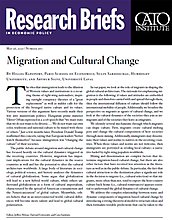The idea that immigration leads to the dilution of Western values and institutions is a recurring theme of right-wing nationalists, inspiring outright conspiracy theories of a “great replacement” as well as milder calls for the protection of the besieged native culture and its values. Various versions of this argument have recently made their way into mainstream politics. Hungarian prime minister Viktor Orbán expressed in a 2018 speech that “we must state that we do not want to be diverse.… We do not want our own color, traditions and national culture to be mixed with those of others.” Just a few months later, President Donald Trump reaffirmed this concern, saying that European leaders “better watch themselves” because immigration was “changing the culture” of their societies.
The public debate around migration and cultural change has focused heavily on the cultural dynamics triggered in the receiving countries. However, migration has important implications for the cultural dynamics in the source countries as well and has the potential to alter the cultural architecture worldwide. A large body of literature in sociology, political science, and history analyzes the dynamics of cultural globalization. Some argue that globalization will lead to a new hybrid world culture, while others understand globalization as a form of cultural imperialism, characterized by the spread of American consumerism and the “Americanization” of global culture. Meanwhile, others believe that in an interconnected world, cultural differences will become more salient and lead to global cultural polarization.
In our paper, we look at the role of migrants in shaping the global cultural architecture. The rationale for emphasizing migration is the following: if values and attitudes are embedded in people and therefore carried with and spread through them, then the international diffusion of culture should follow the international mobility of people. Additionally, we broaden the perspective on migrants as agents of cultural change, and we look at the cultural dynamics of the societies they join as immigrants and of the societies they leave as emigrants.
We identify several mechanisms through which migrants can shape culture. First, migrants create cultural melting pots and change the cultural composition of host societies through mere mixing. Additionally, immigrants may disseminate their values and norms to natives in the receiving countries. When those values and norms are not welcome, then immigrants are portrayed as eroding local culture—a narrative fueled by right-wing populists worldwide.
Mixing and dissemination are complex factors that determine migration-based cultural change, but there are also other factors that have received less attention in the literature as well as in the public debate. In particular, the fact that cultural attraction to the destination plays a significant role in the decision to migrate (i.e., cultural selection) or that migrants, more often than not, tend to export the host-country culture back home (i.e., cultural remittances) appears essential to understand the global dynamics of cultural change.
We address the complex relationship between static and dynamic components of migration-based cultural change by introducing a strong theoretical model to structure ideas and then formulate testable predictions that can be taken to the data. This allows us to establish whether migration makes sending and receiving countries culturally more similar and whether this increase in cultural similarity is indeed driven by the “erosion” of the receiving countries’ values and norms or, conversely, by home countries converging culturally toward host countries.
We make a threefold contribution. First, we develop a theoretical model of migration-based cultural change that investigates how migration affects cultural proximity between home and host countries. To the best of our knowledge, this is the first attempt to integrate the main channels of migration-based cultural change into a unified theoretical framework covering both static and dynamic components, including compositional changes in the host and home societies as well as several cultural diffusion mechanisms, such as assimilation, cultural dissemination from migrants to natives, and social remittances. The advantage of our theory-driven approach is that we are able to shed light on the complex mechanisms behind our empirical results. Second, using the World Values Survey, we develop three time-varying bilateral cultural-distance measures.
These will serve as our outcome variables. And third, we test the predictions of our model for a large number of country pairs between the years 1981 and 2014. We show that migration is associated with an increase in cultural similarity between home and host countries over time (i.e., cultural convergence). We then look at the mechanisms behind such cultural convergence. Our evidence is inconsistent with cultural dissemination from the home country to the host country as the main driver of convergence. Rather, we identify cultural remittances as the dominant force in this process, which puts into question the narrative of a Western culture under threat; if anything, this suggests that immigration can promote the diffusion of the host culture abroad.
NOTE:
This research brief is based Hillel Rapoport, Sulin Sardoschau, and Arthur Silve, “Migration and Cultural Change,” CESifo Working Paper no. 8547, September 2020, https://ssrn.com/abstract=3689469.

This work is licensed under a Creative Commons Attribution-NonCommercial-ShareAlike 4.0 International License.
